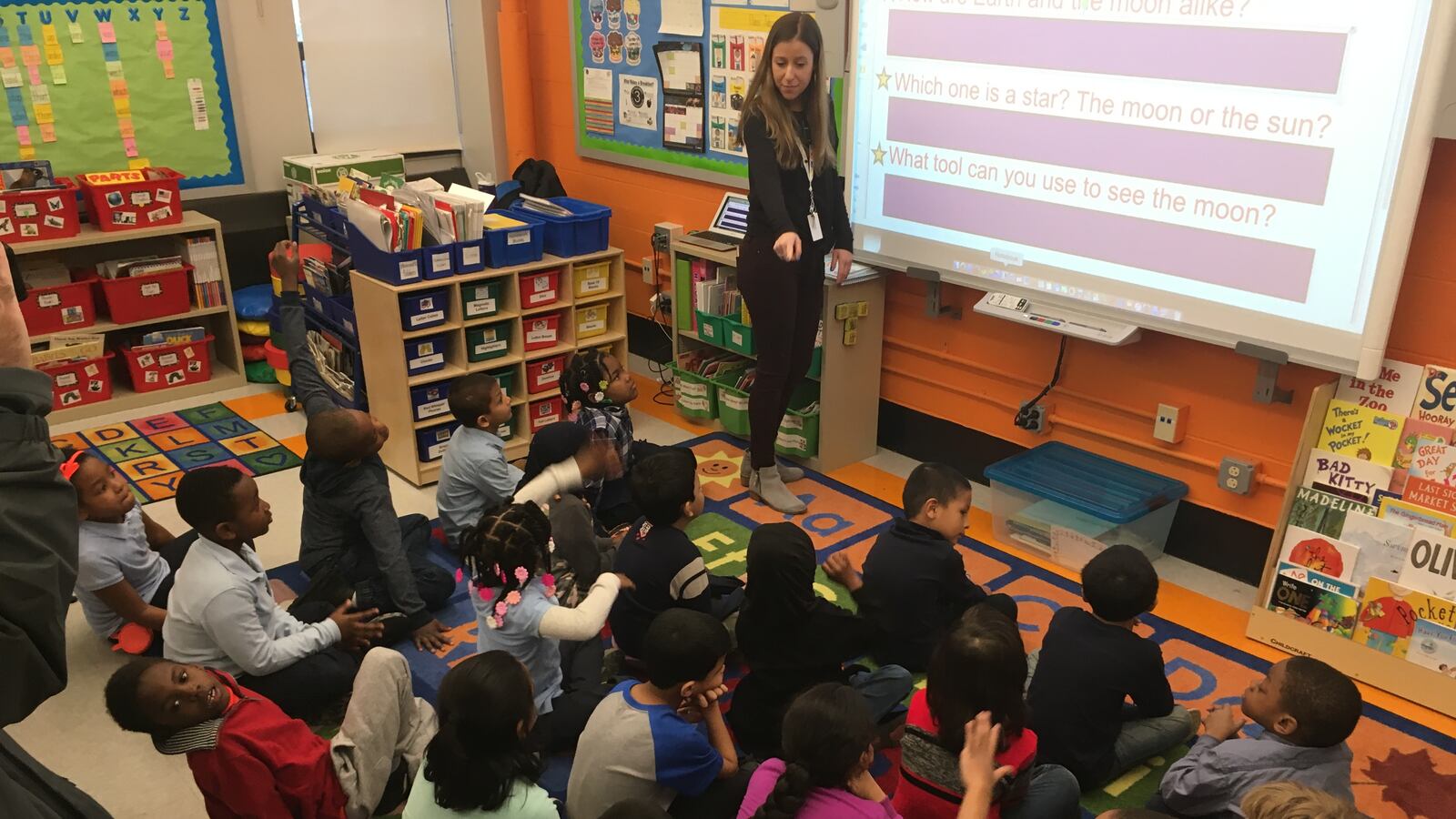This article was originally published in The Notebook. In August 2020, The Notebook became Chalkbeat Philadelphia.
Philadelphia School District officials hosted a visit to Locke Elementary in West Philadelphia to show off one of the modernized classrooms that they hope will boost early-childhood literacy – and to announce that dozens more will soon get the same treatment.
“Even the little stools – they’re rocking stools, so the kids don’t have to keep still. They wiggle! So the kids really like those,” said principal Katherine Carter with a smile, as she stood in one of her newly painted, brightly lit 1st-grade classrooms.
The classroom upgrades aren’t just cosmetic, said Carter, but designed around a “center-based” instruction model. The modernized rooms feature iPads and other new materials, clusters of modular desks, and dedicated spaces for small groups to work on reading, writing, and math.
“I’ve seen improvements in their reading levels,” Carter said. “The instructional centers are much more rigorous, and the students are much more engaged … it’s amazing.”
(Photo: Bill Hangley Jr.)
Locke is one of eight schools in which 80 classrooms were upgraded this year as part of a District push to use its capital investments to boost literacy among young readers.
Next year, Superintendent William Hite announced, the District will modernize an additional 162 classrooms in 11 more schools. This year’s cohort saw all classrooms from pre-K through 2nd grade modernized; next year’s group will have 3rd-grade classrooms upgraded as well.
Hite said that the improvements would help the District achieve its “anchor goal” of getting all of its 8-year-olds reading at grade level and that they reflect Mayor Kenney’s priorities as well.
“This is how the mayor’s recommended budget for the School District is operationalized,” said Hite. “We’re going to continue that investment until we work through as many schools as we possibly can.”
Definitive data isn’t yet available to measure their impact, but Hite and Carter said that students and teachers alike are excited and engaged by the new spaces – and that the early academic returns are encouraging.
“The centers are more instructionally sound and skill-based … as opposed to just games the teachers found on the internet or Pinterest,” Carter said.
And teachers received not only new material, she said, but also plenty of training in how to use it.
“[If] you don’t know how to use the materials, what is the point? But Apple was here to show them how to use the iPad not just as a learning tool, but as a teaching tool,” said Carter. “Or the smartboard, how to be more interactive with it … not just use it as a glorified projector.”
Dara Messing, a 1st-grade teacher whose classroom hosted Tuesday’s visit, said she was delighted with the new setup, which she said was unprecedented in her decade with the District.
“I did Donors Choose a lot,” she said of the crowdfunding website. “But we’ve never had anything like this. We have a more literacy-rich environment, we have iPads which are really engaging – just having the space to have a writing center, a listening center, a library, makes it a lot easier.”
Messing’s classroom includes an extra high-tech bonus: an audio system called Activate that allows her to listen to all the small groups as they work. Cell-phone-sized speakers sit on each center’s desk, and Messing wears a headset. As she works with students in one part of the room, she can use an app on her phone to check up on students in other parts of the room without disturbing them.
Messing said that using the Activate system has confirmed what she long suspected: Just because kids aren’t sitting quietly doesn’t mean they’re not learning.
“If I look over at the library and see three kids looking at the same book together, I can tune in and hear what they’re doing – ‘Oh, they’re really talking about the book, and not just playing together,’” said Messing. “It can look like they’re not doing what they’re supposed to be doing, but they are. That’s what most studies are showing – kids don’t need to be sitting down to learn.”
In addition, students can use the same system to talk to the teacher without disturbing their classmates.
“I was asking the children [about it],” said Hite, “and they said, ‘We can raise our hand, ask a question … and we don’t have to get up and make a lot of noise.’ And I thought, ‘That’s a pretty good explanation.’”
So far, only Messing’s class uses the $2,000 Activate system, but District officials – who originally discovered it while looking for ways to help hearing-disabled students – say they’ll keep an eye on the data to see whether it’s worth spreading around.
But for now, upgraded classrooms will feature the combination of iPads and other materials, new furniture and storage, paint and lighting, and the center-based layout that dedicates spaces for both small-group and whole-group learning. Teachers will get about 20 hours of training to make the most of the new spaces.
Hite said that the most important numbers have yet to come in, but that for now he is “banking on” the enthusiasm he sees translating into better reading scores.
“We don’t have hard data yet, but the data we do have is that more children are attending at these schools,” he said. “More children are engaged [and] teachers are a lot more active in terms of what their children are doing in the classroom.”
This year’s cohort of elementary schools with upgraded classrooms includes Locke, Stearne, Pennell, Lea, Duckrey, Gideon and Meade, as well as Haverford Learning Center.
Next year’s cohort of elementaries will be J.H. Brown, George Childs, Anna B. Day, Louis Farrell, William Hunter, Morton McMichael, J. Rhoads, William Rowen, Steel, John Taggart, and John Webster.


